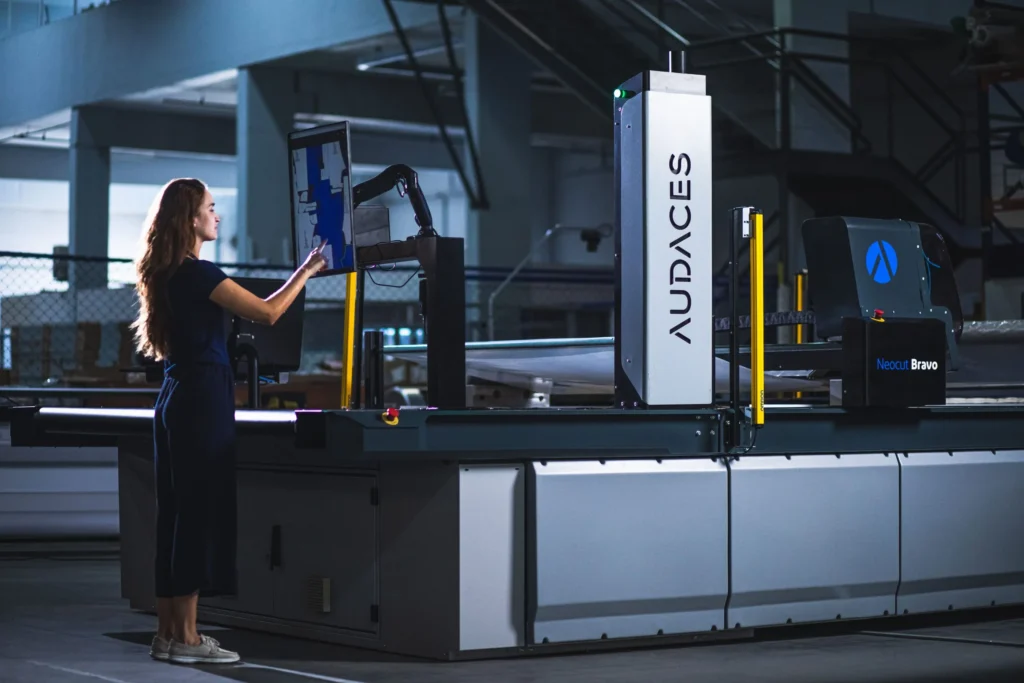Summary
- Cutting is the first step of apparel manufacturing and sets the pace for the rest of the production workflow.
- If there’s a slow cutting process, it means that all the following stages will have difficulty meeting deadlines.
- Discover how technology can eliminate production bottlenecks. Try Audaces360 for free today!
Those in the fashion industry know all too well the pressure of tight deadlines. With ever-changing trends, a competitive market, and demanding consumers, staying ahead of the curve is crucial.
To meet today’s demands, manufacturers need to embrace agility. This means streamlined processes, well-trained staff, and efficient equipment.
We’ve prepared this guide specifically to help you achieve this balance. By addressing slow cutting in your garment manufacturing, the entire workflow will follow suit, leading to faster production times.
Enjoy your reading!
Sumário
What is slow cutting?
Slow cutting is the process of cutting fabric for garment production in a time-consuming and inefficient way.
Often, the cutting department is the source of production delays, but it’s not always obvious. Therefore, listen closely to feedback from other departments.
To address slow cutting effectively, it’s important to identify the root causes of the problem. First, assess the cutting process, observe the staff, and analyze cutting data.
Once you have a better understanding of the issues, you can implement solutions to improve efficiency and speed.
Learn more: How to eliminate 10 common problems in the cutting room
Main causes of slow cutting in apparel companies
This can happen for a variety of reasons, such as:
Unskilled labor
Unskilled or undertrained workers in the cutting department can create a snowball effect on the entire production process.
They may take longer to complete cuts, leading to delays in the rest of the workflow. Additionally, they can struggle with complex markings, requiring rework or supervisor intervention, further slowing down production.
Poor time management
If you lack a clear system to track cut order progress, it’s hard to spot and address any bottleneck. Understanding the complexities of each batch is crucial for setting realistic timeframes and avoiding a slow cutting department.
When the cutting department falls behind, workers in the next stages may have to wait for cut fabric to arrive. This leads to idle time and decreased overall production efficiency.
Excessive errors
Frequent cutting errors create a significant bottleneck in apparel production, leading to several problems. Mistakes require recutting fabric, repairing flawed pieces, or discarding unusable scraps, wasting valuable resources and time.
Moreover, fixing errors causes delays in the entire schedule. Sewing and other departments involved wait longer for corrected cut pieces, leading to missed deadlines.
Learn more: How to obtain quality and precision in the cutting fabric process?
Lack of automation
Manual cutting, while a traditional method, can significantly hinder the speed and efficiency of apparel production.
It is a time-consuming process compared to automated machines. This limits production output and makes it difficult to meet tight deadlines, especially for large orders.
Specialized machinery can cut fabric much faster and more precisely, significantly improving production efficiency.
If you want to receive a free personalized project on how to automate your cutting room, simply fill in your email address below!
Common problems in a slow cutting process
Obviously, problems quickly appear in slow cutting productions. Here are some of the most common ones:
Production delays
When cutting takes longer than expected, it disrupts the entire production schedule. Sewing, printing, and other downstream departments must wait for cut fabric, leading to missed deadlines.
Delayed deliveries can damage customer relationships and lead to lost sales. In addition, companies might rush jobs or use overtime, which can tire out employees and potential quality issues.
Waste of time and resources
Slow cutting not only consumes excessive time but also wastes valuable resources. This is because mistakes or inaccurate cuts lead to unusable fabric scraps.
Furthermore, slow cutting not only drives up material costs but also goes against sustainable practices. In addition to wasting raw materials, companies also have to spend more money on proper disposal.
To add to the problem, inactive machinery or keeping lights on for extended hours increases energy consumption and costs.
Learn more: 6 benefits of automatic cutting for your fashion business
Need for more employees
Some companies may want to hire more workers to speed up production, but this costs even more money.
First, finding and training new staff takes time and resources. Second, having more employees means paying higher wages over time.
Lastly, managing a larger team adds to the workload and costs for managers. Plus, this might not fix the core problems with the cutting process itself.
Variances in cutting
Slow cutting or a poorly managed process can lead to variances in the cut pieces. Mismatched or unevenly cut pieces can cause difficulties during assembly, requiring rework and delays.
The final product may not meet size specifications, potentially leading to product returns. This directly impacts customer satisfaction and the overall brand reputation.
Learn more: Why invest in a good fabric cutting table for garment production?
How does technology help in the cutting process of your production?

The cutting room is the foundation for any successful apparel production process. Traditionally, this stage relied heavily on manual labor, leading to errors and limitations.
However, the rise of cutting-edge technology has transformed the way of cutting garments. These are some of the benefits:
1) Enables complex cuts
Advanced cutting technology allows for the creation of intricate designs and patterns with high precision.
Unlike manual methods, modern machinery can handle complex curves, intricate details, and layered fabrics, enhancing design possibilities.
This opens doors for innovative and eye-catching garment designs that can set your brand apart.
Learn more: 4 reasons you should invest in a cutter room for fashion
2) Achieves greater precision
Human error is a constant concern in manual cutting. Automated cutting machines eliminate this variable, ensuring consistent and accurate cuts every single time. This translates to reduced waste, improved product quality, and a minimized need for rework.
Additionally, consistent cuts lead to a smoother sewing process downstream, further enhancing overall production efficiency.
3) Handles large volumes of fabric
Modern cutting systems always aim for efficiency. They can process large quantities of fabric quickly and seamlessly, keeping up with even the most demanding production schedules.
This is especially beneficial for high-volume production runs and allows you to confidently take on larger orders.
By automating the cutting process, workers are free from repetitive tasks and can work on other parts of production.
Learn more: How can mass production boost your apparel manufacturing?
4) Identifies cut pieces
Automated systems streamline inventory management and reduce errors by tracking and identifying cut pieces. This technology lets you monitor progress, find specific pieces, and minimize mix-ups.
Real-time tracking provides full control over the cutting process. It enables proactive problem-solving and ensures timely delivery of correct pieces to the sewing stage.
Overcome the slow cutting process with Audaces Cutting Room

By embracing cutting-edge technology, garment manufacturers can achieve significant improvements in the production process. From greater design flexibility to enhanced efficiency and reduced costs.
This is where Audaces Cutting Room steps in! Our experts will thoroughly assess your company’s needs and create a comprehensive report.
Then, our team will develop a personalized project tailored to achieve your goals and unlock your company’s full potential.
Rely on Audaces’ cutting-edge machinery to automate your production process. Achieve impeccable cuts on curves and details, speeding up your deliveries and minimizing fabric waste through automation.
Audaces ICF
Audaces ICF is an intelligent technology that seamlessly connects people, hardware, and cutting room systems.
This streamlines production planning and management by providing a digital platform for all stakeholders. All information is available in real time via smartphone.
Managers can effortlessly schedule cut orders, specifying details like spreads, layers, cuts, and fabric quantities.
The system monitors progress and alerts you to any discrepancies between planned and completed tasks. It also provides suggestions for resolving these issues.
Was this article helpful? Receive our content first hand by subscribing to the Audaces newsletter!
FAQ
Slow cutting can lead to delayed production, scheduling issues, increased costs, and inventory management problems.
Slow cutting is the process of cutting fabric for garment production in a time-consuming and inefficient way.
Unskilled labor, poor time management, excessive errors, and lack of automation.










